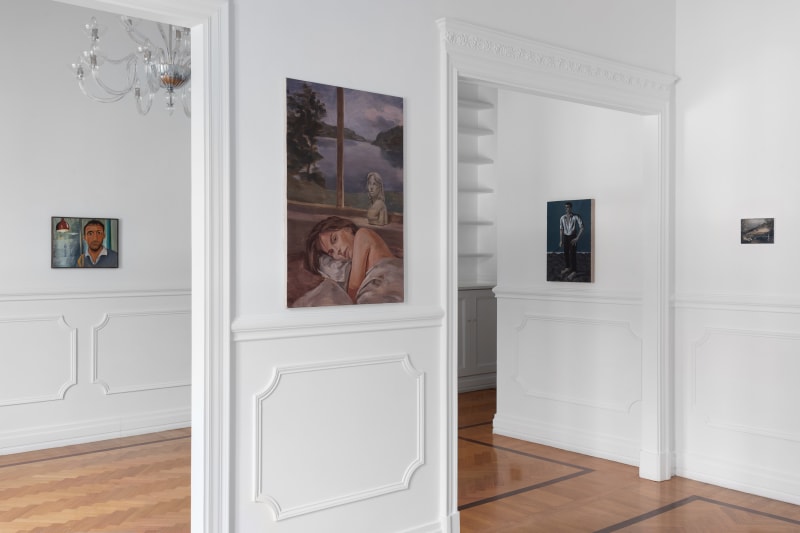NOT TOO FAR, NOT TOO CLOSE
Elias Njima, Lisa Ivory, Ralf Kokke, Mary DeVincentis Herzog, Ṣọlá Olúlòde, Valdrin Thaqi, and Zhang Shangfeng
"NOT TOO FAR, NOT TOO CLOSE" draws on the widely known Goldilocks principle: the proposition that optimal outcomes arise from a state of precise balance. In astrobiology, planets positioned at an exact orbital distance from their star can sustain liquid water, making life possible. In economics, an economy warm enough to sustain steady growth yet cool enough to avoid inflation achieves a balance between growth, employment, and price stability. In developmental psychology, the most effective learning occurs when the complexity of material is calibrated to be neither overly simplistic nor prohibitively challenging.
Standing before a painting is much the same: the most meaningful engagement occurs at just the right physical and psychological distance - close enough to perceive nuance, yet far enough to preserve the work’s autonomy.
Mary DeVincentis’s paintings hover between myth and memory, imagination and lived experience. Never too far as to feel remote, never too close as to dissolve into certainty. Whether a figure lies upon an endless green meadow, seems on the verge of being swept away by a surging stream, or kneels before a fractured sun with a body scattered in green leaves, they dwell in a threshold space. As intermediaries, they embody the fragile balance of proximity and distance, binding together past and future, experience and imagination.
Lisa Ivory’s travellers move through a liminal, mythical terrain, a ruined Eden that hovers between ruin and renewal. They exist in shifting proximity with nature, near enough to spark a fire yet distant enough to drift past. Figures of death and life co-exist, one watching the other from afar, present and absent at once. Within and beyond the canvas, binaries collapse in this space of distance, revealing a fragile balance between intimacy and detachment, belonging and estrangement.
Ralf Kokke paints from memory, dream, and fleeting visual impulse. His figures, at once contemporary and fantastical, are steeped in classical compositional echoes, carrying with them a sense of timelessness. The textured surfaces often resemble ancient cave murals, weighted by their visual density and also by their historical resonance. In Kokke’s work, divergent intentions collapse into a shared destination: the threshold where personal reverie meets collective memory. His paintings stage a dialogue between past and present, where archaic echoes and contemporary visions coalesce into a single, fluid temporality.
Elias Njima’s paintings unfold with the continuity of a novel, sequential and narrative, imbued with an undercurrent of tension. In one, the crimson radiance of a ceiling lamp illuminates a man’s visage while rendering peripheral figures indistinct. In another, blossoms appear opulent yet verge on decay. Each composition induces a suspension, compelling the imagination to extend beyond the pictorial field. The compositions shift attention from daily reality to the hidden corners of memory, where the most distant past meets the nearest future, and where every emotion depends on the right balance of elements.
Ṣọlá Olúlòde’s work is suffused with fluidity, of gender, of relationship, of presence. Often, two figures intertwine yet retain their autonomy, even as they bathe in memories of intimacy, forming a quiet sense of unity. By illuminating these tender, everyday moments, Olúlòde reveals connections that resonate profoundly, held in the delicate balance of not too far, not too close.
Zhang Shangfeng’s work embodies this delicate tension: a man who is growing up yet never fully grown, a confrontation that is at once violent and tender. In one painting, an adult man squeezes into clothes a size too small, hands on his hips as if imitating maturity; in another, a seemingly powerless figure wields a scepter studded with nails. Not too far, not too close, this is the distance of becoming, suspended between childhood play and adult gravity, between vulnerability and resistance to the world.
In Valdrin Thaqi’s painting, a woman reclines beside a window, accompanied by her own sculptural likeness. Beyond her lies an expansive lake and verdant terrain, yet her countenance remains pensive, tinged with melancholy. Far enough to glimpse the vastness beyond, close enough to drift into the quiet of her mind.
Each scene appears poised on the edge of revelation, as if something will happen soon, yet time must still pass. not too far, not too close, just about to happen.
This is also the balance at which the artists create, between internal experience and external reality. Their works occupy the threshold where closeness offers intimacy and distance grants perspective. In stillness, the quiet moments of everyday life are examined, where the mind lingers on the smallest details and beauty emerges from simplicity. Here, not too far, not too close becomes more than a concept; it becomes a way of perceiving, of moving through time - where we’ve been, where we are now, and where we are going. It is an invitation to linger, to sense, to understand, to feel, to meet life in its quiet moments, suspended in the grace of measured distance.







